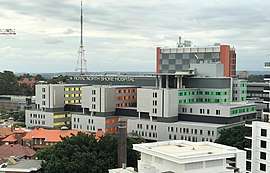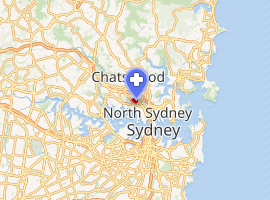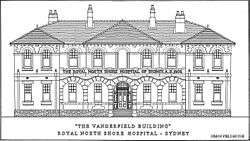Royal North Shore Hospital
The Royal North Shore Hospital (RNSH) is a major public teaching hospital in Sydney, Australia, located in St Leonards. It serves as a teaching hospital for Sydney Medical School at the University of Sydney and has approximately 700 beds. It is the referral hospital for Northern Sydney. Its primary referral area accommodates 5.7% of the Australian population or 17% of the NSW population.
| Royal North Shore Hospital | |||||||||||
|---|---|---|---|---|---|---|---|---|---|---|---|
| Northern Sydney Local Health District | |||||||||||
 | |||||||||||
 Royal North Shore Hospital - April 2019 | |||||||||||

| |||||||||||
| Geography | |||||||||||
| Location | Reserve Road, St Leonards, New South Wales, Australia | ||||||||||
| Coordinates | 33.8222°S 151.1925°E | ||||||||||
| Organisation | |||||||||||
| Care system | Medicare (Australia) | ||||||||||
| Funding | Public hospital | ||||||||||
| Type | General Teaching | ||||||||||
| Affiliated university | Australian Catholic University University of Sydney University of Technology | ||||||||||
| Network | NSW Health | ||||||||||
| Services | |||||||||||
| Emergency department | Yes Adult Major Trauma Centre | ||||||||||
| Beds | 713[1] | ||||||||||
| Helipads | |||||||||||
| Helipad | (ICAO: YXNS) | ||||||||||
| |||||||||||
| Public transit access | St Leonards railway station Sydney bus route 144 | ||||||||||
| History | |||||||||||
| Opened | 1885 | ||||||||||
| Links | |||||||||||
| Website | Royal North Shore Hospital | ||||||||||
Introduction

The Royal North Shore Hospital (RNSH) is a leading tertiary teaching hospital of The University of Sydney, University of Technology and Australian Catholic University. It is also a major Trauma Centre which provides specialised services in the areas of severe burns, neonatal intensive care, spinal cord injury and interventional radiology. The Kolling Institute of Medical Research is a health and medical research centre with a focus on research training.
History
_Royal_North_Shore_Hospital.jpg)
It began as a cottage hospital located in Willoughby Rd, Crows Nest. The foundation stone was laid by Sir Henry Parkes, 18 June 1887. The hospital was opened with accommodation for fourteen patients, with the requisite office and rooms for the medical and nursing staff. Medical staff numbered four honorary doctors and nursing staff numbered five. The site of the original hospital was bounded by Willoughby Rd., Albany and Holterman Streets and Zig Zag Lane. The old site is now a busy part of the commercial centre of Crows Nest.[2] In 1902, it opened on its current site at St Leonards, with 48 beds available for patients. New departments and wards were added over the next fifty years, reflecting the increasing diversity and professionalisation of health care.
Between 1935 and 1940, polio treatment pioneer Sister Kenny Kenny travelled extensively throughout Australia helping to set up clinics. In the mid-thirties, she set up one of her pioneering clinics at RNSH. In 1940, the New South Wales government sent Kenny to America to present her clinical method for treating polio victims to American doctors.[2] Doctors in Minnesota were with her work and convinced her to stay. Her treatments, which revolutionised the care of polio, caused as much controversy in the United States, as they had in Australia. Royal North Shore became a teaching hospital of the University of Sydney in 1947. Currently, the RNSH is a 600-bed hospital situated in St Leonards on Sydney's lower North Shore about 6 km from Sydney's Central Business District, surrounded by suburbs with some of the most stunning harbour views of Sydney. RNSH provides care to the local community, the Northern Sydney Health area (population: 777,000), New South Wales and also to the Pacific Island nations.
In 2008 new facilities were procured under a PPP contract. The selected bidder, InfraShore, includes ABN AMRO, construction company Thiess and service providers Thiess Services, ISS Facility Services and Wilson Parking. The works were carried out by Thiess and completed in 2011.[3]
Hospital Today
Acute Services Building
- New Teardrop shaped helipad capable of supporting two helicopters in an emergency
- Inpatient wards for medical and surgical patients with a combination of one-bed and four-bed rooms
- An outpatient (ambulatory care) center
- A new Comprehensive Cancer Care Centre
- Enhanced diagnostic services
- 18 operating theatres
- Capacity for a 58-bed intensive care unit with single rooms
- Automated guided vehicles to transport food, linen, and waste around the hospital
Clinical Services Building[4]
- 40 Maternity Beds
- 32 Neonatal Intensive Care Beds
- 12 Burns Unit Beds
- 24 Paediatric Beds
- 32 Beds for Mental Health Patients, as well as 12 beds allocated for High Dependence patients.
Community Health Centre
- Aboriginal health services
- Children's health services
- Community mental health
- Drug and alcohol outpatient services
- Opioid treatment program (OTP)
- Renal services
- Sexual assault and sexual health clinic
Douglas Building
- COVID-19 clinic
- Pain management clinic
- 40 bed ward for the treatment of COVID-19 positive patients
- Carer accommodation
- Staff health clinic
Herbert Street Clinic
- 11 bed inpatient unit for detoxification from drug and alcohol addiction
- 4 of 11 beds for the NSW involuntary drug and alcohol treatment program (IDAT)
Current Services
There is currently 5,000 staff working at RNSH.
- Royal North Shore Hospital (RNSH) is a major teaching hospital located in the Northern Sydney Local Health District.
- RNSH provides local health services to four local government areas north of Sydney Harbour – Lane Cove, Mosman, North Sydney and Willoughby and Ryde.
- RNSH has statewide responsibilities in the provision of healthcare. It is one-of-seven major trauma centres in NSW [5] and is the only trauma centre capable of providing care for major burns, spinal injuries, and serious injuries during pregnancy. The RNSH emergency and trauma services are complemented by comprehensive intensive care and diagnostic clinical support services.[6]
- RNSH is also a major referral and tertiary hospital for the area extending north of Sydney Harbour, up to the southern shore of Lake Macquarie, and west to Wiseman’s Ferry.[7]
- RNSH caters for more than 1,110,600 people, which equates to 1 out of every 20 Australians, and 1 in 5 people living in NSW population.[7][8]
- As a major teaching hospital, RNSH has acted as an education facility for University of Sydney undergraduate medical students for more than 60 years and acts as the main headquarters for the program’s Northern Clinical School.[6][9] The hospital’s teaching program involves students of Allied Health and nursing students from University of Technology, Sydney.
- RNSH also provides facilities and support for postgraduate students, scientists and clinicians undertaking research programs in a variety of fields.[6]
- The RNSH campus comprises the Acute Services Building (opened in 2012), the Douglas Building and The Clinical Services Building (opened in December 2014).
- The overall area of the RNSH grounds is approximately 13 hectares, and 11.6 hectares in functional area. It is commonly known as the Royal North Shore Hospital Campus.[7]
- RNSH currently has a maximum capacity to hold 420 acute medical and surgical beds. Overall, including acute overnight and day-only beds, it has a total of 600 beds.
- In 2010, there were 56,354 presentations to the Emergency Department and since the opening of the new Acute Services Building increased presentations have occurred with 61,739 patients requiring assessment and treatment in 2012/13.
- Approximately 3,000 babies are born annually at RNSH.
Medical Units
- Acute Dialysis Unit
- Audiology
- Bone Densitometry
- Major Burns
- Cancer Centre
- Cardiac Cath Labs
- Cardiology
- Paediatrics
- Dermatology
- Emergency Department
- Endocrinology
- Endoscopy
- Haematology
- Intensive Care Unit
- Medical Day Procedure
- Mental Health
- Neonatal Intensive Care
- Neurodiagnostics
- Neurosurgery
- Nuclear Medicine
- Ophthalmology
- Physiotherapy
- Sexual Assault
- Urology
Notable incidents
Following the case of patient Jana Horska, who suffered a miscarriage in the hospital's toilet as a result of lack of available beds and staff, the State Government established the Joint Select Committee on the Royal North Shore Hospital in the New South Wales Parliament on 23 October 2007, chaired by Christian Democrats leader Fred Nile MLC. The committee was formally established on 23 October 2007, and tabled its report on 20 December 2007. The report made 45 recommendations.[10]
In early 2008, a Special Commission of Inquiry into Acute Care Services in NSW Public Hospitals was commissioned.[11] This comprehensive and ground breaking commission became known as The Garling Report. It reported in November 2008. The NSW State Government responded in March 2009. It found a "prevalent" problem associated with the care of the deteriorating patient in NSW public hospitals. As a result, a statewide system of monitoring vital signs to detect deteriorating patients was introduced. This system includes red and yellow "Between the Flags" colour-coded observation charts for recording a person's vital signs, allowing for easy visual recognition of deterioration. Observation charts have been developed for Adult, Paediatric, Maternity and Emergency patients. By 2012 it had been implemented in every public hospital in NSW.
In August 2015, a patient of the outpatient diabetes clinic attended Royal North Shore Hospital for a routine appointment at 9:30am, the patient failed to present to the clinical staff and was subsequently listed as a "no-show" to his appointment. His spouse later concerned that partner had not returned from his appointment contacted Royal North Shore Hospital who advised that her partner did not attend his scheduled appointment. It was not until 6:30am the following day that a cleaner located the man in a public toilet within the hospital premises. It was found that the patient suffered a stroke.[12]
In August 2016, the Royal North Shore Hospital came under fire when it was revealed that doctors at the hospital were issuing restricted antibiotics to tens of thousands of patients, without seeking approval.[13] Northern Sydney Local Health District's system through which approval to prescribe the powerful antibiotics is sought, called eASY, had not been used to generate any of these prescriptions. Use of the eASY system, designed to combat the spread of superbugs, had fallen to just 35% in May 2016.
A foetus was incorrectly cremated in an incident in 2015 that resulted in the parents being unable to bury their child as per their wishes. The admission came after state budget estimates exposed a separate body swap at RNSH, in which the daughter of a deceased patient found that staff had incorrectly tagged her remains.[14]
See also
- Healthcare in Australia
- Lists of hospitals
- List of hospitals in Australia
References
- "Clinical Services Plan 2019-2022" (PDF). NSW Health - Northern Sydney Local Health District. 2017. Retrieved 30 October 2019.
- Sherrington, Geoffrey; Roger Vanderfield (1988). The Royal North Shore Hospital 1888 - 1988: A Century of Caring. Cammeray, Australia: Horwitz Grahame.
- "Royal North Shore Hospital Redevelopment" (PDF). Austrian Construction Achievement Awards. Retrieved 5 January 2020.
- "Clinical Services Building provides additional 29,000 square metres of health services to Royal North Shore Hospital". ESCO Industries. Retrieved 18 December 2017.
- NSW Trauma Services - Institute of Trauma and Injury Management. Accessed November 6, 2016. Available from https://www.aci.health.nsw.gov.au/get-involved/institute-of-trauma-and-injury-management/clinical/trauma_system/nsw_trauma_system/nsw_trauma_services
- Northern Sydney Central Coast Health. Royal North Shore Hospital. New South Wales Health Department. Accessed January 19, 2011. Available from nscchealth.nsw.gov.au/services/003700637.shtml
- Royal North Shore Hospital. Concept Plan. New South Wales Health Department. July 2006.
- Australian Bureau of Statistics. 2006. ‘New South Wales’. Person Characteristics. Accessed January 19, 2011.
- Northern Clinical School. History of the Northern Clinical School. University of Sydney. Accessed January 19, 2011. http://sydney.edu.au/medicine/northern/about/history/index.php
- Joint Select Committee on the Royal North Shore Hospital (20 December 2007). "The Royal North Shore Hospital" (PDF). Parliament of New South Wales. Retrieved 20 December 2007.
- Garling Report, Terms of Reference
- "Stroke victim spent 20 hours lying in Royal North Shore Hospital toilet". Sydney Morning Herald. 13 August 2015. Retrieved 20 May 2020.
- "Royal North Shore doctors putting patients at increased superbug risk". Sydney Morning Herald. 13 August 2016. Retrieved 13 August 2016.
- "Bodies swapped: Dead baby mistakenly cremated and daughter finds mother's body mislabelled at Royal North Shore Hospital". Sydney Morning Herald. 31 August 2016. Retrieved 6 November 2016.